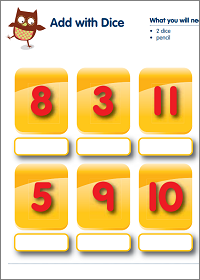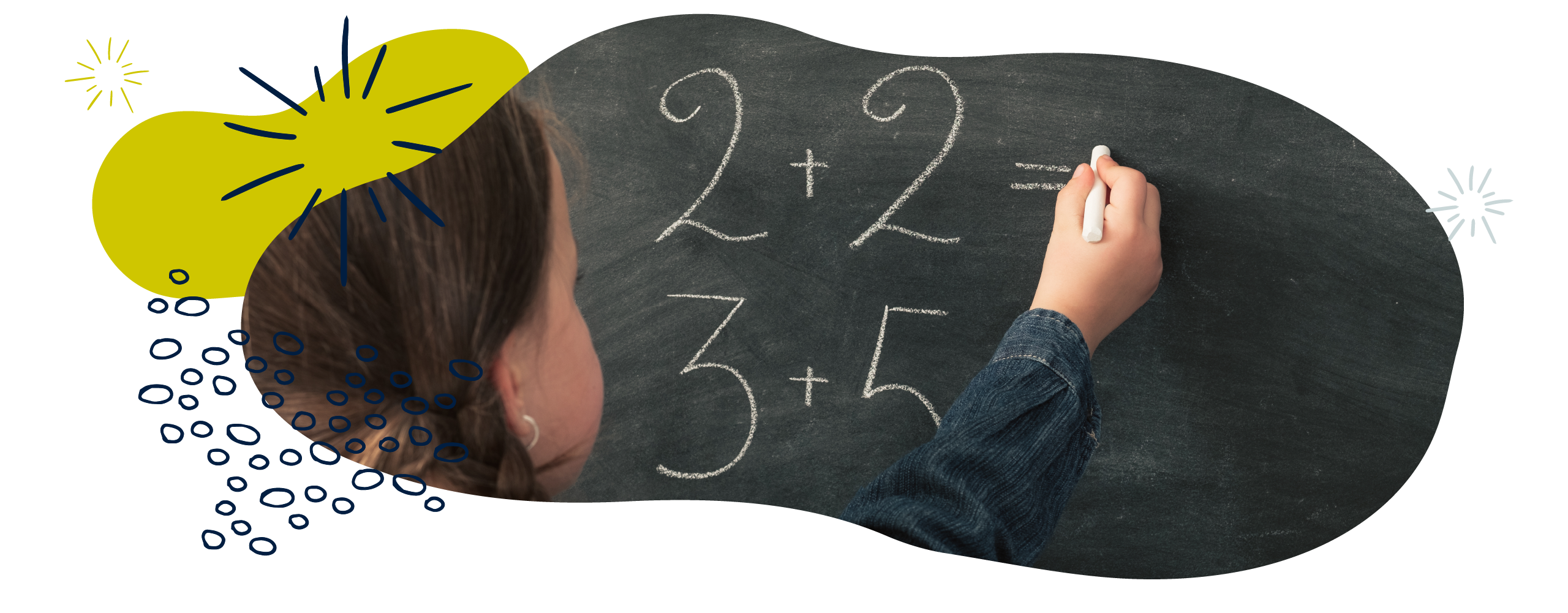Addition & subtraction in Year 1 (age 5–6)
In Year 1, your child will begin to read, write, and understand mathematical ideas using addition (+), subtraction (–) and equals (=) signs. They will practise counting on and will start solving simple word problems.
The key words for this section are equivalence and number bonds.
What your child will learn
Take a look at the National Curriculum expectations for addition and subtraction in Year 1 (ages 5–6):
Understand and use addition (+), subtraction (–) and equals (=) signs
Your child will understand addition, subtraction, and the idea of equivalence. They will also be able to use the ‘+’, ‘–’ and ‘=’ symbols to write calculations, and will be able to understand problems that use these symbols.
They will understand that addition means finding the total of two or more sets of objects or numbers. At first, they will count all objects in the two groups. For example:
If your child has a group of 2 objects and another group of 3 objects, they will count each object in both groups, 1, 2, 3, 4, 5.
Then, they will progress to counting on. This means not always starting from 1, but starting from one of the numbers in the calculation. For example:
If your child has a group of 2 objects and another group of 3 objects, they might start with the 2 objects and count on to find the total: 3, 4, 5.
Your child will start to realise that it is quicker to count on from the larger number in a sum. For example, for the groups of 2 and 3 objects, they will start with the group of 3 and count on 2 more to find the total.
Your child will also know that subtraction means taking away to find how many are left. Objects are very useful for showing how this works. Your child may be introduced to subtraction as difference to begin with. for example, ‘4 – 1’ could be read as ‘What is the difference between 4 and 1?’.
Your child will be expected to use language such as put together, add, altogether, total, take away, distance between, difference between, more than and less than when adding and subtracting.
Use number bonds and related subtraction facts up to 20
Your child will make and use number bonds up to 20. Number bonds are the different ways to make a number. For example, the number bonds to 4 are:
4 and 0
3 and 1
2 and 2
1 and 3
0 and 4
Your child will learn the pairs of numbers that make 10, and will use their understanding to work out the pairs of numbers that make 20.
Your child will also be expected to know the related subtraction facts up to 20. For example:
If 9 + 7 = 16 …
Then 16 – 7 = 9 and 16 – 9 = 7.
Your child will also know that adding zero to a number means it doesn’t change.
Add and subtract one-digit and two-digit numbers to 20
Your child will add and subtract numbers by using objects, drawing diagrams, and writing calculations down.
Your child will be expected to add and subtract one-digit and two-digit numbers with answers from 0 to 20. For example, 27 – 11 = 16.
Solve one-step problems and missing number problems
6 + 4 = ?
If I buy 6 apples and 4 oranges, how many pieces of fruit do I have altogether?
Your child will use a range of objects, drawings, diagrams, and symbols to solve addition and subtraction problems. They will also solve missing number problems involving addition and subtraction, such as 7 = ? – 9.
How to help at home
There are lots of ways you can help your child to understand addition and subtraction. Here are just a few ideas:
1. Play the Number Facts Pairs game
Your child needs to know a range of number facts involving addition and subtraction. Number facts are facts that we know immediately, without the need to calculate, like 2 + 2 = 4.
For instance, it is very important for your child’s future learning that they are able to recall the different ways we can partition (break apart) numbers from 1–10. You can help them learn by playing Number Facts Pairs together!
- Write out the numbers 1 to 10 two times, making 20 separate number cards.
- Turn the cards face down and pick one at random. This is the number you are going to try to make.
- Now, take it in turns to pick up cards. Add each card you pick up together until you get to the target number. If you go too high, you can use your turn to put back one of the cards you have picked up, face down.
- When a player reaches the target number, they win!
There are lots of fun variations of the game you could try. Why not add in higher numbers, or see how many targets you can reach within two minutes?
2. Focus on subtraction
Your child will be expected to know subtraction facts up to 10. They will begin by subtracting one from a set of objects and noticing that the set has decreased in size. Encourage your child to relate subtraction to taking away by showing them how it works in everyday situations.
For example, if your child has a handful of raisins, ask them how many they have. When they have eaten one, ask them how many they now have left. Do they have more raisins or fewer raisins? What happens if you eat two raisins at the same time? Using real objects or drawings and removing the ones that you want to subtract helps your child to visualise what subtracting really means.
3. Play dice games
There are lots of ways you can encourage your child to solve addition and subtraction problems practically – all you need are two dice.
In school, they will be taught that addition is when we add two groups of objects together or when we have an amount to start with and then add more to it, making the total increase. You could play a game where each player rolls two dice and has to find the total. The winner is the player who has the largest total.
You could use similar games for subtraction. For example:
Start with a given number of objects, say 12. Then, take it in turns to roll a six-sided die.
The first player to roll subtracts the number shown on the die from the 12 objects and works out how many they have left. They take away the objects they have subtracted.
The next player will then roll the die, and takes away their number from the remaining pile of objects. Play continues until all objects are removed. The player with the most objects at the end of the game is the winner.
You could ask the child to record a calculation for each roll of the die, such as 12 – 3 = 9.
Finally, why not play board games with two dice? These offer a great opportunity to practise number bonds, as well as teaching other useful skills like counting and waiting for their turn.
Activity: Add with dice

Roll two dice and add them together.
4. Focus on counting on
Help your child practise addition by combining two or more sets of objects. For example, if you have 4 grapes and your child has 7 grapes, ask them to find out how many grapes there are in total. Your child may count each grape one at a time to find the total amount.
To ensure that they count each grape accurately, it might be a good idea to ask your child to place the grapes in a row. Your child may be able to begin solving addition by ‘counting on’. In this method, the child could start with the 4 grapes and then count on 7 more to find the total, i.e. 5, 6, 7, 8, 9, 10, 11. You could then support your child to record what they have done using symbols, i.e. 4 + 7 = 11.
If your child likes collecting stickers, ask them how many they have already. Then ask them how many they would have if you gave them 2 more. This will encourage them to begin ‘counting on’ from the original amount to solve the addition problem, which is much quicker than counting every sticker!
5. Subtraction as difference
Your child is likely to be taught about subtraction as ‘difference’. For example:
’10 – 8′ can also be thought of as ‘What is the difference between 10 and 8?’
Use objects to help your child understand the concept of difference. Why not ask your child to sort their toys into groups, and then see if they can figure out which groups have more or fewer objects? You could then ask them to compare two of the groups.
What is the difference between your child’s number of fluffy toys and their number of hard toys? What about the difference between their red toys and their blue toys? Putting the two groups next to each other in a line is a good way to quickly spot the difference between them.
Encourage your child to record their thinking as a subtraction calculation. For example:
If they have 6 red toys and 2 blue toys, then the difference is 4. This can be written as 6 – 2 = 4.
